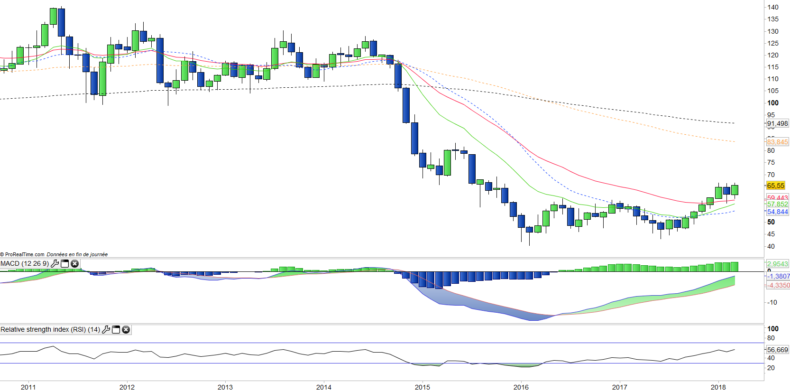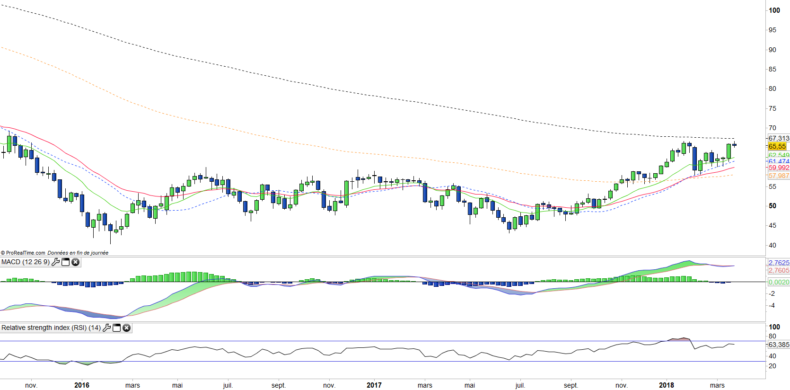PowerShares Oil WTI - DBO - 27/03/2018
Short Term strategy: Positive (90%) / Trend +
Long Term strategy: Positive (65%) / Trend =
Characteristics of the ETF
The DBO ETF (Invesco-Powershares) created in 05/2007 replicates the crude oil prices through future contracts on light sweet crude oil (WTI).
The costs of the DBO ETF are 0.75% and AUM amount to approximately $483M. Oil is a very volatile asset, and as any commodity does not give rise to a dividend and is a risky asset.
Alternative ETFs: OLO (Deutsche Bank USD), BNO (US Commodity Fund USD).
Latest developments
WTI oil rose for the second consecutive year in 2017 (+ 4.9%) after a rebound of 9.2% in 2016 and rose by 9.3% in 2018.
The good behavior of WTI in recent weeks, despite adverse statistics of US stocks, is mainly dictated by geopolitics. Indeed the new D.Trump cabinet composed of J.Bolton and M.Pompeo is in favor of a very hard line against Iran that could lead straight to the war in the coming months which would set the region ablaze and would cause a surge in crude prices. In addition, the "production gap" remain in the background and is expected from 2019 which corresponds to the underinvestment of oil companies since 2014 and which cannot be filled indefinitely by shale oil, especially taking into account a natural erosion of 5% of the wells capacity.
The main risk in this scenario would be a negative shock on the demand side, in case of a negative turnaround of the world economy or economic war between the different blocks that would lead to a slowdown in trade.
Index & components
Oil is a commodity that is a fossil fuel produced by a few countries like Saudi Arabia, the US, Russia, Iran, Iraq, Algeria or Nigeria.
It is extracted by drilling or hydraulic fracturing and is then delivered - processed / refined or not, in consumer countries, mainly European and Asian and can produce fuels such as gasoline, gas oil or kerosene once refined and processed chemically.
Depending on its origin and final destination, oil has different names and its price may also vary. These differences in the price of oil depend on its quality. We differentiate the Arabian Light, which comes from the Middle East, the Brent oil that is produced in the North Sea, and finally the WTI or "West Texas Intermediate" which is produced in the United States and is the benchmark of the oil market.
The reference unit for oil is the barrel, which is actually about 159 liters. The price of a barrel of oil is quoted on the international market continuously, while two financial centers share its rating, namely New York for WTI and London for Brent.
Supply, therefore production and its stability are of course key determinants of the price of a barrel. It is OPEC, made up of several major world producing countries, which is in charge of determining - by consensus - how many barrels a day will be produced and its publications are therefore followed with attention by traders, as was the case recently.
Demand factors are also critical. Thus, an increase in the energy needs of a major consumer country may have a greater or lesser influence on the price of the barrel. Globally, global growth is a very important factor for demand, while oil needs tend to shrink at equal demand, as new technologies tend to reduce consumption. In the long term, the electric car could cause a negative shock on global demand for crude oil, as China is investing heavily in renewable energy.
Since 2014, oil prices have divided by 3 due to a supply shock caused by the arrival on the market of American shale oil which has put very strong pressure on the oil-producing and oil companies that have significantly reduced their investments. This stoppage of industrial investment, in addition to OPEC's production cuts, has for the moment had a moderate bullish impact on crude prices. This is due to the plethoric production of unconventional oil (shale) that floods the market and counterbalances OPEC's reduction efforts.
Monthly data

On the monthly chart, we can observe an increasingly positive structure, which has managed to settle above monthly moving averages and is positioned on the two-year highs. This structure shows a bullish candlestick in March that seems to announce an upward momentum towards the $ 80 zone. The technical oscillators are well oriented for a new upward phase.
Weekly data
The weekly chart shows the bullish restart of the WTI which, after a few weeks of pause is at the level of the major resistance constituted by the EMA200 located at the level of $ 67. This resistance is tested for the second time in a few weeks, so it is weakened and should yield to the buying pressure. Crossing the EMA200 would be a significant improvement in the trend that would clearly become bullish in the long run.
ETF Objective
DBO is an ETF listed in $ which seeks to replicate the DBIQ Optimum Yield Crude Oil Index Excess Return
Characteristics
| Inception date | 01/05/2007 |
| Expense ratio | 0,78% |
| Issuer | Powershares (Invesco) |
| Benchmark | Futures Oil WTI |
| code/ticker | DBO |
| ISIN | US73936B5075 |
| Currency | $ |
| Exchange | NYSE |
| Assets Under Management | 341 M$ |
| Dividend | No |
| Currency risk | No |
| Number of Holdings | NS |
| Risk | 4/5 |
Country Breakdown
| USA | 100% |
Sector Breakdown
| Oil WTI | 100% |
Top Ten Holdings
| Oil WTI | 100% |

